 W
WAlbertosaurines, or dinosaurs of the subfamily Albertosaurinae, lived in the Late Cretaceous of United States and Canada. The subfamily was first used by Philip J. Currie, Jørn H. Hurum and Karol Sabath as a group of tyrannosaurid dinosaurs. It was originally defined as "(Albertosaurus + Gorgosaurus)", including only the two genera. The group is sister clade to Tyrannosaurinae. In 2007, it was found that the group also contained Maleevosaurus, often synonymized with Tarbosaurus. However, this classification has not been accepted, and Maleevosaurus is still considered a juvenile Tarbosaurus or Tyrannosaurus.
 W
WAnoualerpeton is an extinct genus of lissamphibian in the family Albanerpetontidae. Fossils have been found of two different species in Forest Marble Formation of England, the Kilmaluag Formation of Scotland, and the Ksar Metlili Formation of Morocco dating back to the Bathonian stage of the Middle Jurassic and the Berriasian stage of the Early Cretaceous, respectively.
 W
WAntetonitrus is a genus of sauropod dinosaur found in the Early Jurassic Elliot Formation of South Africa. The only species is Antetonitrus ingenipes. As one of the oldest known sauropods, it is crucial for the understanding of the origin and early evolution of this group. It was a quadrupedal herbivore, like all of its later relatives, but shows primitive adaptations to use the forelimbs for grasping, instead of purely for weight support.
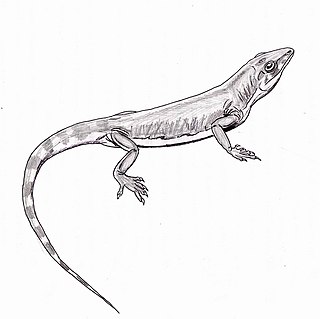 W
WArchaeovenator is an extinct genus of Late Carboniferous varanopid synapsids known from Greenwood County, Kansas of the United States. It was first named by Robert R. Reisz and David W. Dilkes in 2003 and the type species is Archaeovenator hamiltonensis. Archaeovenator hamiltonensis is known from the holotype KUVP 12483, a three-dimensionally preserved, nearly complete and articulated skeleton, including the skull, with limbs and girdles slightly separated from postcranial skeleton. It was collected in the Hamilton Quarry, from the Calhouns Shale Formation of the Shawnee Group, dating to the Virgilian stage of the Late Pennsylvanian Series, about 300 million years ago. The generic name is derived from the Latin Archaeo and venator, meaning "ancient hunter". The specific name is named after its finding place Hamilton Quarry. Archaeovenator is the oldest and the basalmost known varanopid, as it is the sister taxon to all other known varanopsids.
 W
WAviatyrannis is a genus of carnivorous tyrannosauroid theropod dinosaur from the Kimmeridgian stage of the Late Jurassic found in Portugal.
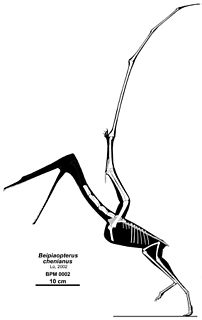 W
WBeipiaopterus is a genus of ctenochasmatid pterosaur from the Early Cretaceous period of what is now the Yixian Formation of the China.
 W
WBradoponera is an extinct genus of ant in the Formicidae subfamily Proceratiinae, and is one of four genera of the subfamily. The genus contains four described species Bradoponera electrina, Bradoponera meieri, Bradoponera similis, and Bradoponera wunderlichi. The species are known from several Middle Eocene amber fossils which were found in Europe.
 W
WBrasilitherium, from "Brazil" and therium, thus meaning "Brazilian beast", is an extinct genus of cynodonts that lived during the Middle to Late Triassic in what is now Brazil. It was approximately 12 centimetres (4.7 in) long and weighed around 20 grams (0.044 lb). It probably fed on insects. Brasilitherium was found in the Candelária Formation of the Paraná Basin in southeastern Brazil. Brasilitherium represents a transition between advanced cynodonts and mammals, having features of both and having early evolution of certain mammalian features, such as hearing and a nasal cavity.
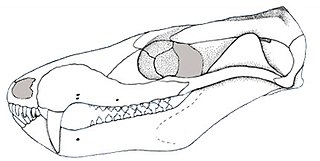 W
WBrasilodon is an extinct genus of cynodonts that lived during the Norian age of the Late Triassic Period, about 228 to 208.5 million years ago. The average length of Brasilodon is approximately 12 cm and weighed about 20 grams. The average size of this cynodont species is about the size of extant mice. Brasilodontids are most likely insectivores due to their teeth. The two species in this genus are B. tetragonus and B. quadrangularis, two very small cynodonts belonging to the family Brasilodontidae.
 W
WBrownimecia is an extinct genus of ants, the only genus in the tribe Brownimeciini and subfamily Brownimeciinae of the Formicidae. Fossils of the single identified species, Brownimecia clavata, are known from the Middle Cretaceous of North America. The genus is one of several ants described from Middle Cretaceous ambers of New Jersey. Brownimecia was initially placed in the subfamily Ponerinae, until it was transferred to its own subfamily in 2003; it can be distinguished from other ants due to its unusual sickle-like mandibles and other morphological features that makes this ant unique among the Formicidae. The ant is also small, measuring 3.43 millimetres (0.135 in), and a stinger is present in almost all of the specimens collected. The morphology of the mandibles suggest a high level of feeding specialization.
 W
WBullacephalus is an extinct genus of biarmosuchian therapsids belonging to the family Burnetiidae. The type species B. jacksoni was named in 2003. It is known from a relatively complete skull and lower jaw, discovered in the Late Permian Tapinocephalus Assemblage Zone of the Beaufort Group of South Africa.
 W
WBunostegos is an extinct genus of pareiasaur parareptile from the Late Permian of the Agadez Region in Niger. The type species, Bunostegos akokanensis, was named from the Moradi Formation in 2003. It was a cow-sized animal with a distinctive skull that had large bony knobs, similar in form to those of other pareiasaurs but far larger. The species appears to have lived in a desert in the centre of the supercontinent of Pangaea.
 W
WChunerpeton tianyiensis is an extinct species of salamander from the Late Jurassic Daohugou Beds in Ningcheng County, Nei Mongol, China. It is the only species classified under the genus Chunerpeton. It was a small animal measuring 18 cm in length.
 W
WColepiocephale is a genus of pachycephalosaurid dinosaur from Late Cretaceous deposits of Alberta, Canada. It was collected from the Foremost Formation. The type species, C. lambei, was originally described by Sternberg, and later renamed by Sullivan in 2003. C. lambei is a domed pachycephalosaur characterized principally by the lack of a lateral and posteriosquamosal shelf, a steeply down-turned parietal, and the presence of two incipient nodes tucked under the posterior margin of the parietosquamosal border.
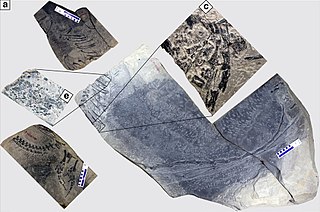 W
WDinocephalosaurus is a genus of long necked, aquatic protorosaur that inhabited the Triassic seas of China. The genus contains the type and only known species, D. orientalis, which was named by Li in 2003. Unlike other long-necked protorosaurs, Dinocephalosaurus convergently evolved a long neck not through elongation of individual cervical vertebrae, but through the addition of cervical vertebrae that each have a moderate length. Like other tanystropheids, however, Dinocephalosaurus probably used its long neck to hunt for prey, utilizing a combination of suction, created by the expansion of the throat, and the fang-like teeth of the jaws to ensnare prey. It was probably a marine animal by necessity, as suggested by the poorly-ossified and paddle-like limbs which would have prevented it from going ashore.
 W
WDromaeosauroides is a genus of dromaeosaurid theropod dinosaur from the Early Cretaceous of what is now Denmark. It was discovered in the Jydegaard Formation in the Robbedale valley, on the island of Bornholm in the Baltic Sea. This is the only likely place for dinosaur remains to be discovered on Danish territory, since the Mesozoic deposits exposed in the rest of the country are marine. Dromaeosauroides is the first known dinosaur from this location, and the only one which has been scientifically named. It is one of the oldest known dromaeosaurs in the world, and the first known uncontested dromaeosaur from the Early Cretaceous of Europe.
 W
WEkorus ekakeran is a large extinct mustelid that inhabited late Miocene Kenya.
 W
WEquijubus, is a genus of herbivorous hadrosauroid dinosaur from the Early Cretaceous of northwestern China.
 W
WEstoniadiscus is an extinct genus of animal of unknown classification, possibly belonging to Bilateria, from the Early Cambrian (Nemakit-Daldynian–Atdabanian) of Estonia. Originally described as a species of Scenella in 1888a, it was redescribed as a possible stem-brachiopod in 2003.
 W
WEusaurosphargis is an extinct genus of a diapsid reptile, known from the Middle Triassic Besano Formation of northern Italy and Prosanto Formation of south-eastern Switzerland. It contains a single species, Eusaurosphargis dalsassoi.
 W
WFukuisaurus is a genus of herbivorous ornithopod dinosaur that lived during the Early Cretaceous in what is now Japan. The type species is F. tetoriensis, which was named and described in 2003.
 W
WThe genus Halictus is a large assemblage of bee species in the family Halictidae. The genus is divided into 15 subgenera, some of dubious monophyly, containing over 200 species, primarily in the Northern Hemisphere. Most species are black or dark brown, sometimes metallic greenish-tinted, with apical whitish abdominal bands on the terga.
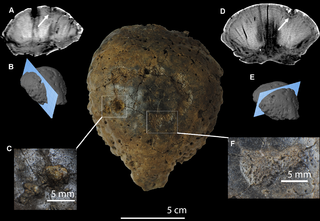 W
WHanssuesia is a genus of pachycephalosaurid dinosaurs from the late Cretaceous period. It lived in what is now Alberta and Montana, and contains the single species Hanssuesia sternbergi.
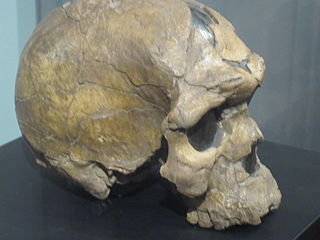 W
WHomo sapiens idaltu, also called Herto Man, is the name given to a number of early modern human fossils found in 1997 in Herto Bouri, Ethiopia. They date to around 160,000 years ago.
 W
WIsisaurus is a genus of titanosaur sauropod dinosaur from the Late Cretaceous Period from what is now India.
 W
WJammerbergia is an extinct genus of mastodonsauroid temnospondyl within the family Mastodonsauridae. The only species is Jammerbergia formops, named in 2003 from the Cynognathus Assemblage Zone of South Africa.
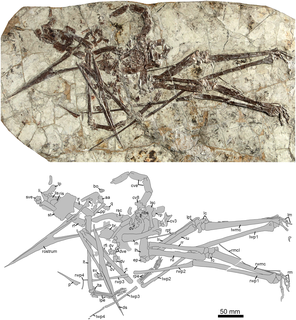 W
WJidapterus is a genus of azhdarchoid pterodactyloid pterosaur from the Aptian-age Lower Cretaceous Jiufotang Formation of Chaoyang, Liaoning, China. The genus was in 2003 named by Dong Zhiming, Sun Yue-Wu and Wu Shao-Yuan. The type species is Jidapterus edentus. The genus name is derived from Jílín Dàxué or "Jilin University" and a Latinised Greek pteron, "wing". The specific name means "toothless" in Latin.
 W
WKaikaifilusaurus is an extinct genus of rhynchocephalians in the family Sphenodontidae from the Late Cretaceous of South America. Fossils of the genus were found in Cenomanian sediments of the Candeleros Formation and Turonian layers of the Huincul Formation, both of the Neuquén Basin and the Albian strata of the Cerro Barcino Formation in the Cañadón Asfalto Basin, all in Patagonia, Argentina. The genus contains two species, K. minimus and the type species K. calvoi.
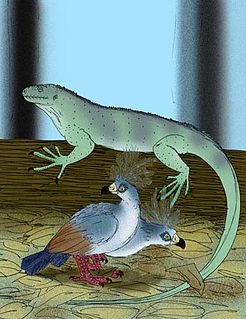 W
WLapitiguana impensa is an extinct giant iguanid from Fiji. It probably became extinct following the human colonization of Fiji 3000 years ago.
 W
WLeogorgon is a genus of large-bodied therapsid from the Late Permian of Russia. It was originally classified as a rubidgeine gorgonopsian, and would have been the first member of that clade from outside of Africa if that identification had been valid. However, it may instead be a combination of the tooth of a gorgonopsian and the braincase of a dicynodont, and may be a nomen dubium.
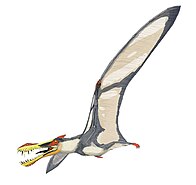 W
WLiaoningopterus, sometimes misspelled "Liaoningopteryx", was a genus of anhanguerid pterodactyloid pterosaur from the Barremian-Aptian-age Lower Cretaceous Jiufotang Formation of Chaoyang, Liaoning, China.
 W
WLudodactylus is a genus of pterodactyloid pterosaur from the Early Cretaceous period of what is now the Crato Formation of the Araripe Basin in Ceará, Brazil. The type and only species is L. sibbicki. The generic name Ludodactylus refers to the fact that the animal had the combination of teeth and a Pteranodon-like head crest, similar to many toy pterosaurs, and no such creature was known to exist until the discovery of Ludodactylus. However, Ludodactylus is not the only pterosaur known to possess these features, the ornithocheirid Caulkicephalus is another example.
 W
WLusotitan is a genus of herbivorous brachiosaurid sauropod dinosaur from the Late Jurassic Period of Portugal.
 W
WMagnirostris, from the Latin magnus "large" and rostrum "beak", is the name given to a genus of dinosaur from the upper Campanian stage in the Upper Cretaceous. It was a ceratopsian which lived in Inner Mongolia in China. It is distinguished from other protoceratopsids by its large beak and incipient orbital horn cores.
 W
WMaotherium is a genus extinct symmetrodont mammal that was discovered in Early Cretaceous rocks in Liaoning Province, China, in 2003. Its scientific name directly translates to "fur beast", in reference to the impressions of fur around the fossil. Maotherium belongs to an extinct group of Mesozoic mammals called symmetrodonts. Though little is known about this group, the symmetrodonts have several similarities - specifically their teeth. They have tall pointed, but simple molars in a triangular arrangement. Originally symmetrodonts were known since the 1920s. Now a vast majority have been restored, such as Zhangheotherium and Akidolestes, during the early 21st century. One of the fossils of Maotherium preserved the imprints of fur, like the mammals Eomaia and Sinodelphys.
 W
WNovialoidea is an extinct clade of macronychopteran pterosaurs that lived from the latest Early Jurassic to the latest Late Cretaceous, their fossils having been found on all continents except Antarctica. It was named by Alexander Wilhelm Armin Kellner in 2003 as a node-based taxon consisting of the last common ancestor of Campylognathoides, Quetzalcoatlus and all its descendants. This name was derived from Latin novus "new", and ala, "wing", in reference to the wing synapomorphies that the members of the clade possess. Unwin (2003) named Lonchognatha in the same issue of the journal that published Novialoidea and defined it as Eudimorphodon ranzii, Rhamphorhynchus muensteri, their most recent common ancestor and all its descendants. Under Unwin's and Kellner's phylogenetic analyses, and because Novialoidea was named first, Lonchognatha is an objective junior synonym of the former. However, other analyses find Lonchognatha to be valid or synonymous with the Pterosauria.
 W
WOlorotitan was a genus of lambeosaurine duckbilled dinosaur from the middle or latest Maastrichtian-age Late Cretaceous, whose remains were found in the Udurchukan Formation beds of Kundur, Amur Region, Far Eastern Russia. The type, and only species is Olorotitan arharensis. It was one of the last non-avian dinosaurs and it went extinct during the Cretaceous–Paleogene extinction event.
 W
WOsmolskina is a genus of archosauriform reptile which lived during the Early Triassic in what is now Poland. The type species, Osmolskina czatkowicensis, was described by Magdalena Borsuk−Białynicka and Susan Evans in 2003. The generic name honors the late female Polish paleontologist Halszka Osmólska.
 W
WPamelaria is an extinct genus of allokotosaurian archosauromorph reptile known from a single species, Pamelaria dolichotrachela, from the Middle Triassic of India. Pamelaria has sprawling legs, a long neck, and a pointed skull with nostrils positioned at the very tip of the snout. Among early archosauromorphs, Pamelaria is most similar to Prolacerta from the Early Triassic of South Africa and Antarctica. Both have been placed in the family Prolacertidae. Pamelaria, Prolacerta, and various other Permo-Triassic reptiles such as Protorosaurus and Tanystropheus have often been placed in a group of archosauromorphs called Protorosauria, which was regarded as one of the most basal group of archosauromorphs. However, more recent phylogenetic analyses indicate that Pamelaria and Prolacerta are more closely related to Archosauriformes than are Protorosaurus, Tanystropheus, and other protorosaurs, making Protorosauria a polyphyletic grouping.
 W
WPhosphatodraco is a genus of azhdarchid pterodactyloid pterosaur from a late Maastrichtian-age Upper Cretaceous portion of the Oulad Abdoun Phosphatic Basin, Grand Doui, near Khouribga, central Morocco.
 W
WPriosphenodon is an extinct Rhynchocephalian known from the Late Cretaceous of Argentina. It is believed to have been a fairly large herbivore, having a longer snout than modern tuatara, with teeth specialised for shearing plant matter. In fact, a recent study found several structural similarities to mammal teeth. Two species are known, P. avelesi and P. minimus.
 W
WRajasaurus is a genus of carnivorous abelisaurid theropod dinosaur from the Late Cretaceous of India, containing one species: Rajasaurus narmadensis. The bones were excavated from the Lameta Formation in the Gujarat state of Western India, probably inhabiting what is now the Narmada River Valley. It was formally described by palaeontologist Jeffrey A. Wilson and colleagues in 2003 based on a partial skeleton comprising the braincase, spine, hip bone, legs, and tail–a first for an Indian theropod. The dinosaur likely measured 6.6 metres (22 ft), and had a single horn on the forehead which was probably used for display and head-butting. Like other abelisaurids, Rajasaurus was probably an ambush predator.
 W
WRinconsaurus is a genus of titanosaur sauropod dinosaur from the Late Cretaceous in what is now Argentina. The type species, Rinconsaurus caudamirus, was described by Calvo and Riga in 2003, and is based on three partial skeletons.
 W
WShenzhousaurus is a genus of basal ornithomimosaur from the Lower Cretaceous of China.
 W
WSilesaurus is a genus of silesaurid dinosauriform from the Late Triassic, approximately 230 million years ago in the Carnian faunal stage of what is now Poland.
 W
WSinodelphys is an extinct mammal from the Early Cretaceous. To date, it is the oldest metatherian fossil known, estimated to be 125 million years old. It was discovered and described in 2003 in rocks of the Yixian Formation in Liaoning Province, China, by a team of scientists including Zhe-Xi Luo and John Wible.
 W
WSinopterus was a genus of tapejarid pterodactyloid pterosaur from the Aptian-age Lower Cretaceous Jiufotang Formation of Chaoyang, Liaoning, China. It was first described and named by Wang Xiaolin and Zhou Zhonghe. Three species have been classified in this genus, though only two are generally considered to be valid. Sinopterus is known for its proportionally large skull, which has a birdlike pointed beak, a long bony crest that starts with a tall premaxilla and goes back along the middle of the skull to form a point overhanging the rear of the skull, and its lack of teeth.
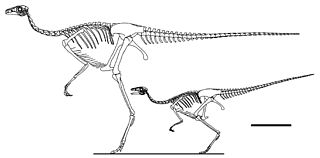 W
WSinornithomimus is a genus of ornithomimid that lived in Asia during the Late Cretaceous period. The first remains were found in 1997, in the Late Cretaceous strata of the Ulansuhai Formation located at Alshanzuo Banner, Inner Mongolia Autonomous Region, Northern China.
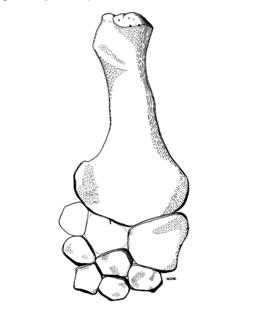 W
WTatenectes is a genus of cryptoclidid plesiosaur known from the Upper Jurassic of Wyoming. Its remains were recovered from the Redwater Shale Member of the Sundance Formation, and initially described as a new species of Cimoliosaurus by Wilbur C. Knight in 1900. It was reassigned to Tricleidus by Maurice G. Mehl in 1912 before being given its own genus by O'Keefe and Wahl in 2003. Tatenectes laramiensis is the type and only species of Tatenectes. While the original specimen was lost, subsequent discoveries have revealed that Tatenectes was a very unusual plesiosaur. Its torso had a flattened, boxy cross-section and its gastralia exhibit pachyostosis (thickening). The total length of Tatenectes has been estimated at 2–3 meters (6.6–9.8 ft).
 W
WTeratophon is an extinct genus of procolophonine procolophonid parareptile from middle Triassic deposits of Free State Province, South Africa. It is known from the holotype BP/1/4299, a nearly complete skull. It was collected by the South African palaeontologist, James W. Kitching from Hugoskop in the Rouxville District and referred to subzone B of the Cynognathus Assemblage Zone of the Burgersdorp Formation, Beaufort Group. It was first named by Sean P. Modesto and Ross J. Damiani in 2003 and the type species is Teratophon spinigenis. It was first assigned to a species of Thelegnathus, Thelegnathus spinigenis.
 W
WTethysaurus is an extinct genus of tethysaurine mosasauroid from the Early Turonian period. The only species is Tethysaurus nopcsai.
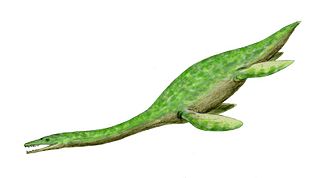 W
WThililua is a genus of polycotylid plesiosaur, containing one species, T. longicollis. The name Thililua is derived from that of an ancient aquatic god from local Berber mythology; longicollis refers to the animal's long neck. Thililua has been found in Late Cretaceous rocks in the High Atlas mountains of Morocco in north Africa. Thililua is the first Polycotylid plesiosaur discovered in Africa, and also the first discovered that lived at a subtropical latitude. In 2010, Thililua was transferred to Leptocleididae as a sister taxon to Nichollssaura.
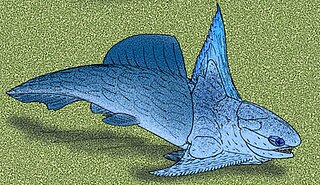 W
WTurrisaspis elektor is an extinct species of groenlandaspid arthrodire placoderm . It is known only from trunk fragments from the Catskill Formation from the Upper Devonian of Clinton County, Pennsylvania .
 W
WTurrisaspis elektor is an extinct species of groenlandaspid arthrodire placoderm . It is known only from trunk fragments from the Catskill Formation from the Upper Devonian of Clinton County, Pennsylvania .
 W
WYixianosaurus is a maniraptoran theropod dinosaur genus from the Early Cretaceous of China.
 W
WZalmoxes is an extinct genus of rhabdodontid ornithopod dinosaur from the Maastrichtian of Romania. The genus is known from specimens first named as the species Mochlodon robustum in 1899 by Franz Nopcsa before being reclassified as Rhabdodon robustum by him in 1915. In 1990 this name was corrected to Rhabdodon robustus by George Olshevsky, and in 2003 the species was once more reclassified, this time as the type species Zalmoxes robustus. Zalmoxes refers to the Dacian deity Zalmoxis, and robustus to the robustness of the remains. In 2003 another species was named, Zalmoxes shqiperorum, named for the Albanian name for Albanians.
 W
WZhongjianichthys rostratus is an extinct basal chordate that lived in the Cambrian period, approximately 530 million years ago. It is sometimes regarded as an early fish, and therefore as one of the first vertebrates. Zhongjianichthys is named after Zhongjian in China.
 W
WZupaysaurus is a genus of early theropod dinosaur living during the Norian stage of the Late Triassic in what is now Argentina. Fossils of the dinosaur were found in the Los Colorados Formation of the Ischigualasto-Villa Unión Basin in northwestern Argentina. Although a full skeleton has not yet been discovered, Zupaysaurus can be considered a bipedal predator, up to 4 metres (13 ft) long. It may have had two parallel crests running the length of its snout.